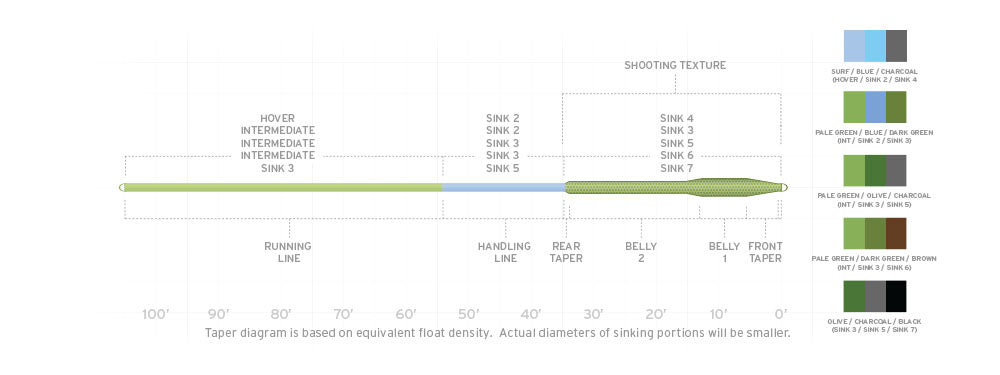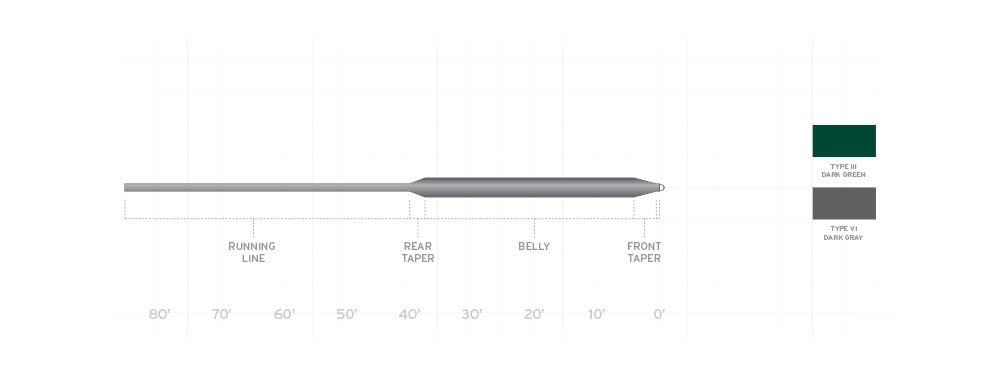Available 24/7 via chat

The Basics of Sinking Fly Lines
Sinking fly lines can be very complicated to someone who has always thrown standard floating lines. This guide will help you get a basic understanding of the language of sinking lines, and their applications.
Sinking fly lines can be very complicated to someone who has always thrown standard floating lines. This guide will help you get a basic understanding of the language of sinking lines, and their applications.
One of the most important things to understand is sink rate, and the terminology used to describe them. Fly line sink rate is measured in inches per second (ips). Going from the slowest sink rate to the fastest sink rate we have:
- Hovering (H) - This line will barely break the water's surface and sinks at about 0.5ips. Most hovering lines are incorporated in a triple density line. Which is where a line has three different sink rates.
- Intermediate (I) - This line sinks at about 1-2 ips. Intermediates are a great choice for swim flies in shallow rivers. This is our most used sink rate for smallmouth in PA.
- Sink 3 (S3) - This line will sink at about 3-4 ips. A S3 is a great option for someone using big streamers for trout.
- Sink 6 (S6)- This line will sink at about 6-7 ips. A S6 is a good line for trout or smallmouth fishing in lakes or deep rivers. Sink 6 is also what a lot of saltwater anglers will use for striper fishing in the northeast.
*There are more variations of sink rate that exceed S6, but there are few applications we would use them in for our fisheries in PA. For sinking rate, the abbreviation S and T can be used interchangeably.
Another key aspect to understanding sinking fly lines is grain weight. GRAIN WEIGHT DOES NOT MEAN HOW FAST OR SLOW A LINE WILL SINK. Grain weight is used to match the weight of a rod. For example, a Scientific Anglers Sonar Titan Sink Tip WF7 F/S comes in Intermediate, S3, and S6. That means all sink rates are the same grain weight to match a 7-weight rod.
Sinking lines can also change sink rates throughout a single fly line. There are many different options for sink rates throughout a fly line. The following list will explain some of the common forms of these lines.
TRIPLE DENSITY

This diagram shows a triple-density sinking fly line. If we look at the top line it shows the line is hovering/sink2/sink4 (H/S2/S4). This line will sink, but at different rates with the head being the fastest sinking.
FULL SINKING

A full sinking line has one sink rate from the butt of the line to the head. These lines can go for anything from intermediate to S15. These lines are not as user-friendly as the sink tips.
SINK TIP

A sink tip fly line has a running line that will float and a portion of the head that will sink. The sink rate in this particular Scientific Anglers Sonar Titan Sink Tip is intermediate, sink 3, or sink 6. The length of the sinking portion changes for grain weight and particular line. These lines are great for wading as they make handling the running line much easier.
I hope this helped you get an understanding of sinking fly lines. If you have any questions, reach out to us at Precision Fly and Tackle. We would love to help get you set up to throw streamers on a sinking line for trout or smallmouth.


Leave a comment